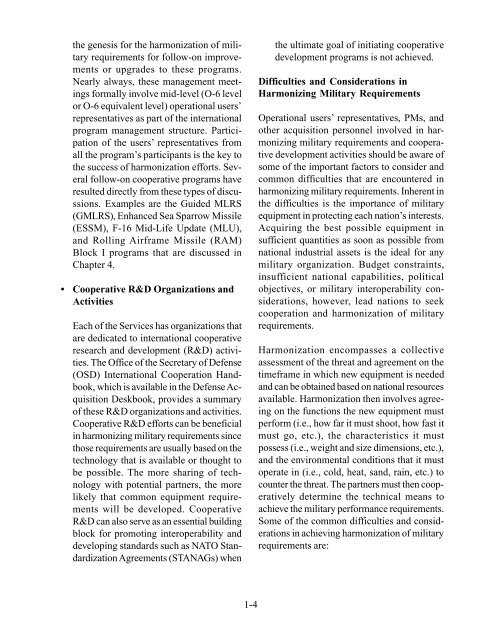Transatlantic Armaments Cooperation - Federation of American ...
Transatlantic Armaments Cooperation - Federation of American ...
Transatlantic Armaments Cooperation - Federation of American ...
Create successful ePaper yourself
Turn your PDF publications into a flip-book with our unique Google optimized e-Paper software.
the genesis for the harmonization <strong>of</strong> military<br />
requirements for follow-on improvements<br />
or upgrades to these programs.<br />
Nearly always, these management meetings<br />
formally involve mid-level (O-6 level<br />
or O-6 equivalent level) operational users’<br />
representatives as part <strong>of</strong> the international<br />
program management structure. Participation<br />
<strong>of</strong> the users’ representatives from<br />
all the program’s participants is the key to<br />
the success <strong>of</strong> harmonization efforts. Several<br />
follow-on cooperative programs have<br />
resulted directly from these types <strong>of</strong> discussions.<br />
Examples are the Guided MLRS<br />
(GMLRS), Enhanced Sea Sparrow Missile<br />
(ESSM), F-16 Mid-Life Update (MLU),<br />
and Rolling Airframe Missile (RAM)<br />
Block I programs that are discussed in<br />
Chapter 4.<br />
• Cooperative R&D Organizations and<br />
Activities<br />
Each <strong>of</strong> the Services has organizations that<br />
are dedicated to international cooperative<br />
research and development (R&D) activities.<br />
The Office <strong>of</strong> the Secretary <strong>of</strong> Defense<br />
(OSD) International <strong>Cooperation</strong> Handbook,<br />
which is available in the Defense Acquisition<br />
Deskbook, provides a summary<br />
<strong>of</strong> these R&D organizations and activities.<br />
Cooperative R&D efforts can be beneficial<br />
in harmonizing military requirements since<br />
those requirements are usually based on the<br />
technology that is available or thought to<br />
be possible. The more sharing <strong>of</strong> technology<br />
with potential partners, the more<br />
likely that common equipment requirements<br />
will be developed. Cooperative<br />
R&D can also serve as an essential building<br />
block for promoting interoperability and<br />
developing standards such as NATO Standardization<br />
Agreements (STANAGs) when<br />
1-4<br />
the ultimate goal <strong>of</strong> initiating cooperative<br />
development programs is not achieved.<br />
Difficulties and Considerations in<br />
Harmonizing Military Requirements<br />
Operational users’ representatives, PMs, and<br />
other acquisition personnel involved in harmonizing<br />
military requirements and cooperative<br />
development activities should be aware <strong>of</strong><br />
some <strong>of</strong> the important factors to consider and<br />
common difficulties that are encountered in<br />
harmonizing military requirements. Inherent in<br />
the difficulties is the importance <strong>of</strong> military<br />
equipment in protecting each nation’s interests.<br />
Acquiring the best possible equipment in<br />
sufficient quantities as soon as possible from<br />
national industrial assets is the ideal for any<br />
military organization. Budget constraints,<br />
insufficient national capabilities, political<br />
objectives, or military interoperability considerations,<br />
however, lead nations to seek<br />
cooperation and harmonization <strong>of</strong> military<br />
requirements.<br />
Harmonization encompasses a collective<br />
assessment <strong>of</strong> the threat and agreement on the<br />
timeframe in which new equipment is needed<br />
and can be obtained based on national resources<br />
available. Harmonization then involves agreeing<br />
on the functions the new equipment must<br />
perform (i.e., how far it must shoot, how fast it<br />
must go, etc.), the characteristics it must<br />
possess (i.e., weight and size dimensions, etc.),<br />
and the environmental conditions that it must<br />
operate in (i.e., cold, heat, sand, rain, etc.) to<br />
counter the threat. The partners must then cooperatively<br />
determine the technical means to<br />
achieve the military performance requirements.<br />
Some <strong>of</strong> the common difficulties and considerations<br />
in achieving harmonization <strong>of</strong> military<br />
requirements are:
















